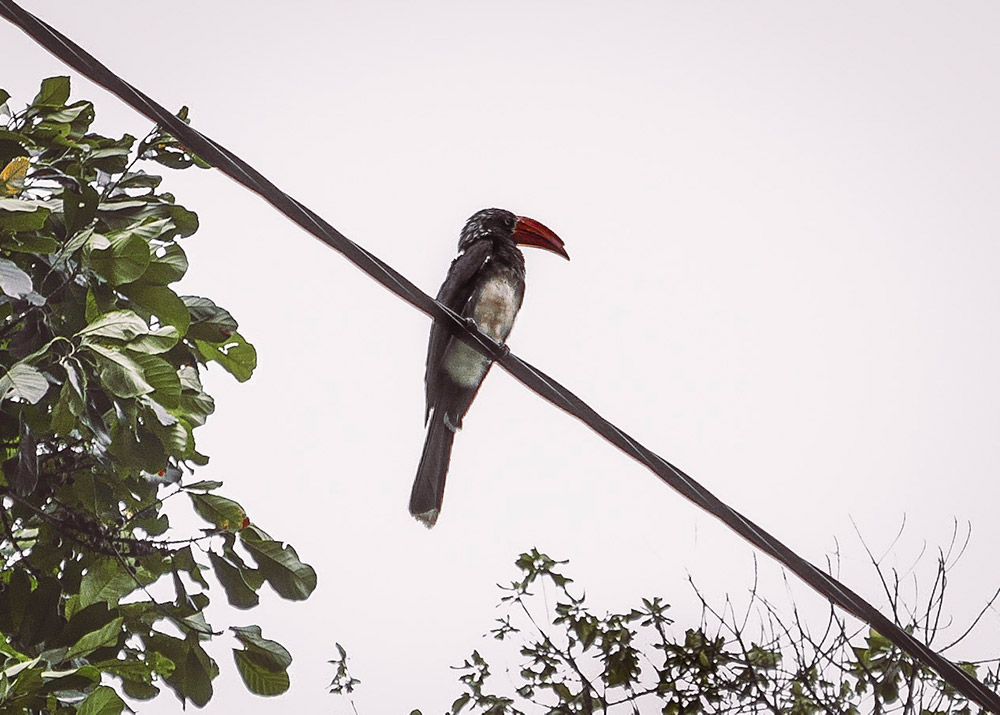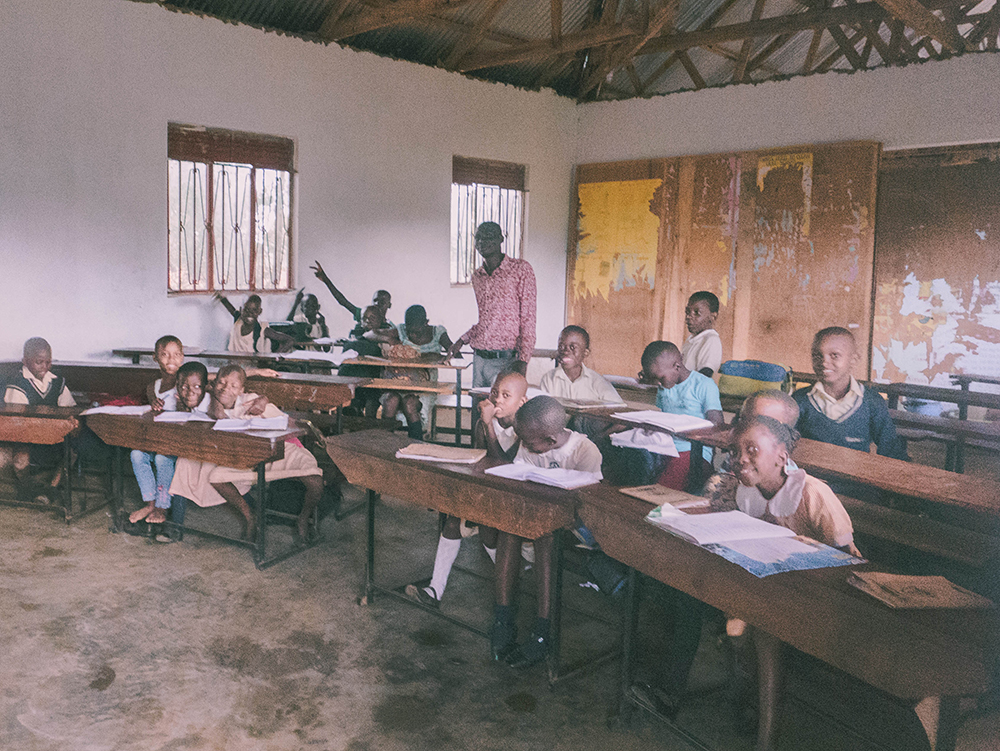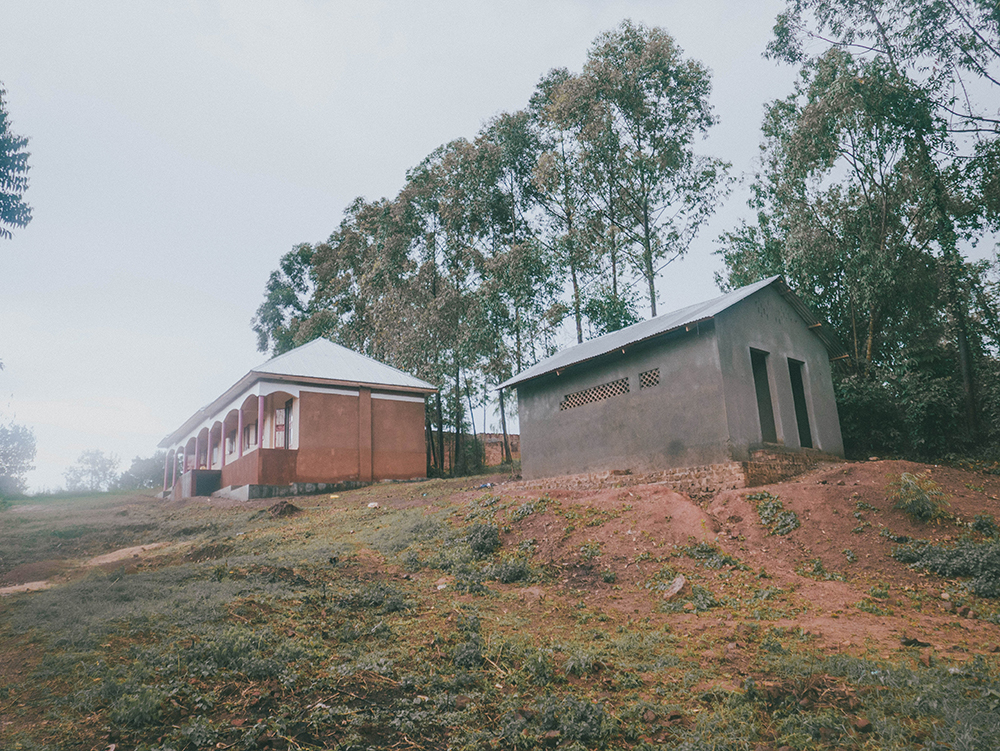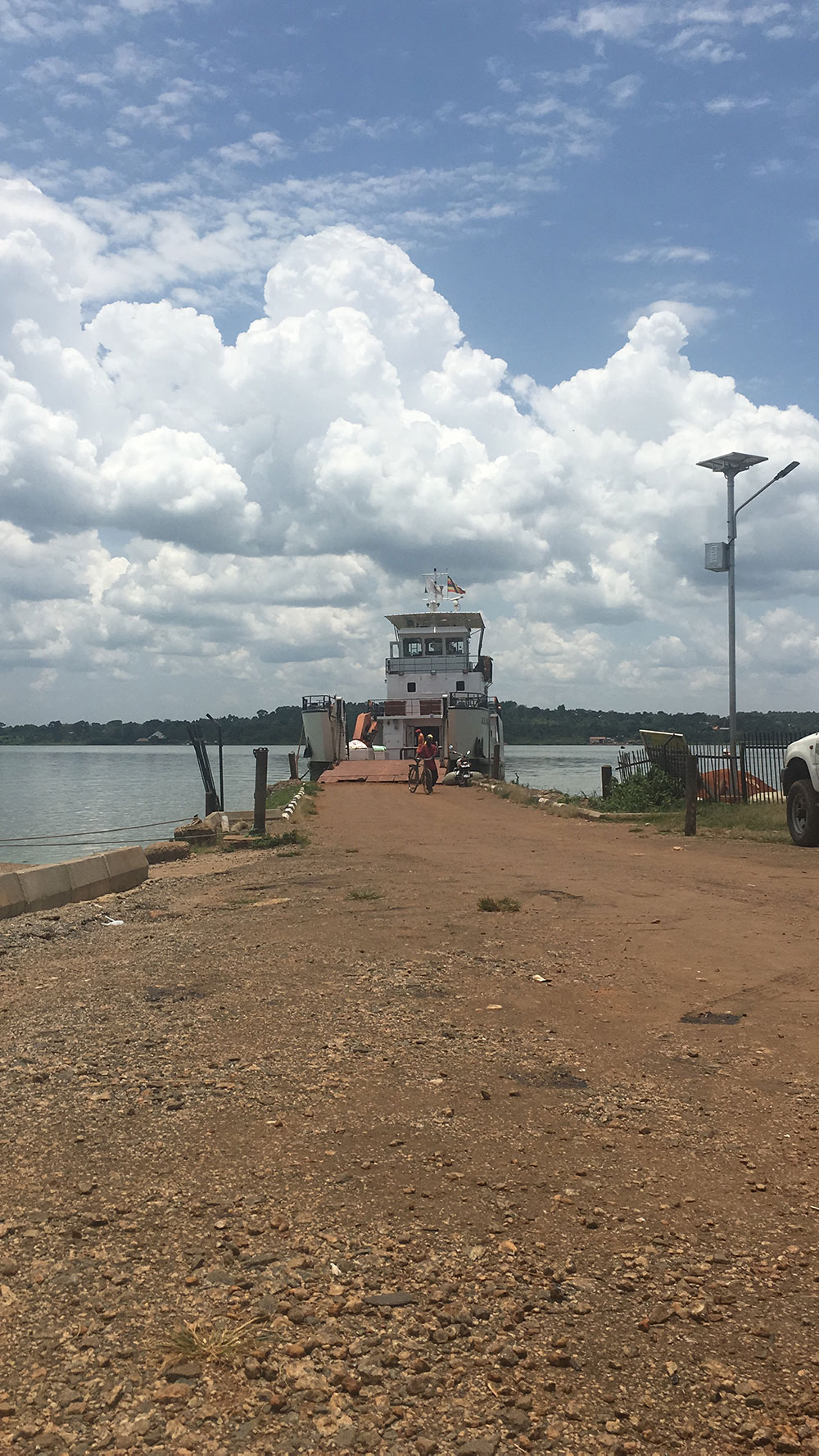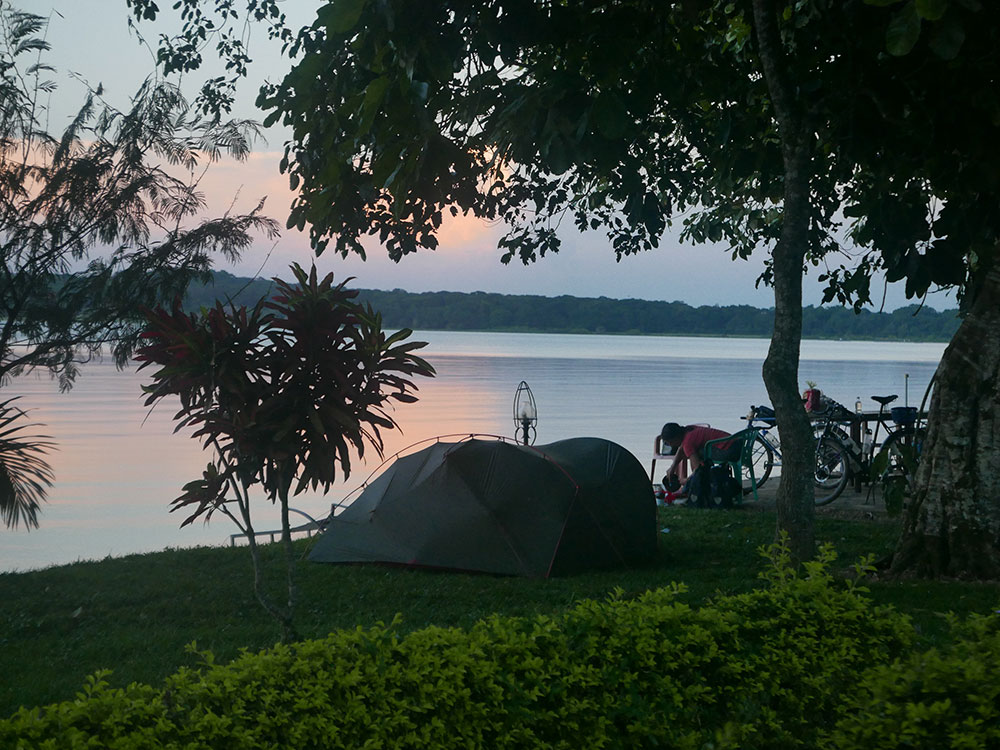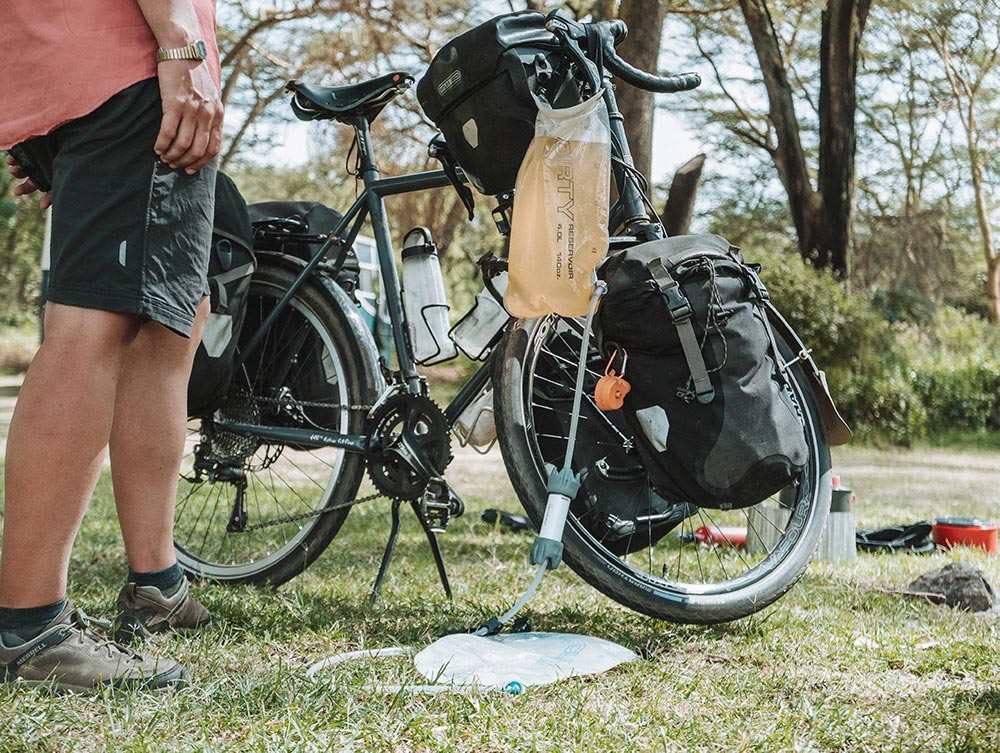07/03/19-13/03/19
Country: Uganda
Distance: 124 km / 77 mi
Elevation: 1,232 m / 4,042 ft
Birds spotted (identified with the help of Dan’s Mam): marabou stork, hamerkop, crowned hornbill, black and white casqued hornbill, black crowned crane.
It was back to school again this week as we popped in to meet St Vianney Primary School, which is another school East Africa Children’s Project work with. Coincidently it was only a couple of days’ ride from the last one, although we very nearly didn’t make it before school was out for the weekend…
After checking out of our hotel, we were barely 20 km down the road when my gear cable snapped and the cable head got stuck in the shifter. Exactly the same thing that happened in India a few months’ ago. If you remember we didn’t have the right sized screwdriver to take the shifter apart, so hunted down a bike guy to help. Well you won’t be surprised to learn that we never did buy the right sized screwdriver, so we were stuck again. We pushed the bikes — as it was in the hardest gear again — around the small town we were in and, after visiting several garages and hardware shops, managed to locate the right tool. Fool me once, shame on you; fool me twice, shame on me; fool me a third time, stop being so lazy. After we fitted the new cable, we asked to buy the mechanic’s screwdriver. He obviously grossly overcharged us, but no doubt we’ll be needing it again, so we paid the price.
Gear cable replaced, on we cycled. Not long after that we witnessed a horrific hit and run. A truck, heading in the opposite direction to us, railroaded a moped carrying three men off the road and just carried on driving. The moped was in the hard shoulder, I might add. We stopped to see if they were okay, since there was no one else around — they didn’t look good. Thankfully a crowd of locals appeared quickly and began seeing to the guys, who were at least moving. Since there was literally nothing we could do to help, we carried on… with slight terror in our eyes. Just around the corner an ambulance passed us, presumably to tend to the guys. Ugandan roads really are as terrifying as people say they are. Stick to the dirt road, kids.
We finally arrived at the guest house we had marked on Google Maps, which was close to the school, only to learn that the location had been inputted wrong. Give us strength. This has become a pet peeve of ours — how can people get this so wrong? It was 2.30pm by now and a teacher had actually spotted us cycle past and come after us thinking we’d got lost. With no sign of the guest house, or any others for that matter, we went to class.
Wow. What a reception we got from St Vianney Primary School. We were ushered into the hall and onto some chairs before thumping music kicked in and an epic dance show ensued. Kids from each year performed synchronised routines to their favourite songs. They were super talented and had clearly put a lot of effort into putting this show on for us. We were very honoured. Here’s a snippet of the show.
At the end of the performance we introduced ourselves, the trip and why we had paid them a visit. Then we asked if anyone had any questions about our ride. I think some kids misunderstood the brief, as we got asked: Who was the first European to come to Africa? And why do Europeans like the Kenyan Highlands? We did get asked what a map is though and what happens if our bikes break, so some kids got it.
All questioned-out, one of the school’s founding members gave us a tour of St Vianney. He explained that before the school existed, there were many orphaned children in his village who had no way to pay for school and no access to a state school. Rather than trying to find tuition fees for so many kids, they decided to find the salary for a teacher who could teach them. And that’s how the school started. St Vianney is a private school, which means they don’t get any money off the government. Kids’ tuition fees cover everything from teachers’ salaries to new equipment and classrooms. He said if parents can’t afford it one term, for whatever reason, their child doesn’t come. East Africa Children’s Project has worked a lot with St Vianney over the years, helping fund a toilet block, mattresses and bedding for the boarding students, new classrooms, and more.
When the bell rang for the weekend we headed to the capital: Kampala. Well after a night in a local guest house. Cycling into the city was a nightmare. I don’t know if you’ve noticed, but we’ve avoided most big cities on this trip — Oslo, Delhi, Nairobi. Unless there’s something specific we want to see or do, we tend to skip them. Saves the stress and the ridiculous amount of money we seem to spend there.
We did have stuff to do in Kampala though, so we had to suffer city traffic. It was horrendous — deadly even – with several near misses with matatus. Matatus are taxi minibuses that drive like no one else is on the road. They curb crawl for fares, dominating the hard shoulder, which is where we take refuge from other road users. But no rules apply on Ugandan roads, particularly for matatus. Let’s not just blame them, they’re not the only ones who drive dangerously— everyone does really. In India, a death stare usually stopped drivers pulling out on you at a junction. In Uganda a look doesn’t stop them. Not only do they pull out whatever the gap, they stare right back in a I’m-bigger-than-you-and-there’s-nothing-you-can-do-about-it kinda way. Bamboozled by the tarmac drama we only made it to the phone shop to fix my Internet and KFC to eat chicken (which is crazy expensive). In the madness we forgot about everything else we had to do. It was only the following day when we remembered. Yes that’s how stressful it was.
Because we forgot to do everything, we had to delay our Ssese Island arrival and venture to the closest shopping mall. There we finally found sun cream, which has proved really hard to find in Uganda, despite all the tourist towns. And would you believe? It’s only Boots Sultan – how random. Then we got cash, got food, got ground coffee. We even found a blow-up mattress for Dan, but for $100 we said no. If you remember his broke a few weeks back. Well Thermarest sent a new one to the UK, as they couldn’t guarantee it would actually arrive in Uganda. Dan’s Mam will bring it to Tanzania in May when she comes out. Luckily for Dan I could sleep on a stair banister if I had to, so he’s been using my Thermarest and I’ve been using the yoga mat we sporadically use for yoga. Then we ferried to the Ssese Islands.
Just to give you an idea of how big Lake Victoria is, here’s the journey we made. The little red line in the top left is the ferry from Entebbe to Bugala – it took 3.5 hours.
The Ssese Islands are an archipelago of eighty-four islands on Lake Victoria. They reckon about forty-three of them are inhabited, with Bugala being the largest and the one where all the tourists go (although we barely saw a soul). The 3.5 hour ferry was a killer on the bum, as we were crammed on the deck, huddled amongst the bikes. But the bum ache was worth it as the island was beautiful. We pitched our tent right on the water’s edge at one of the resorts. The water looked so inviting, but we’d read online hippos and crocodiles are known to lurk beneath the blue, so we stayed dry. Also the water supposably carries bilharzia (schistosomiasis), which is a disease caused by parasitic worms. Infestation occurs when parasites that are released by certain types of freshwater snails come in contact with the skin or are ingested. It’s common for schistosoma parasites to break through the skin. Shockingly it’s the second most socioeconomically devastating parasitic disease after malaria. As if hippos and crocodiles weren’t enough, yet another reason to stay clear. Ironically, however, we reckon the shower was probably water pumped from the lake. Fingers crossed no parasite hopped onboard as we were washing our bits and pits.
With not an awful lot to do on the island, except enjoy the peace and quiet, we barely moved from the same spot. And that’s where we ended our week. Check back next week, there’s a small chance we’ll still be here at this rate, as one day already rolled into two.
WATER FILTERING
You might have seen already that I mentioned our water cleaning process on our Instagram this week. In case you missed it, or wanted more info on the filters/process, I thought I’d add a bit more detail on our blog.
Platypus Gravity Works 4 L Filter System: The reviews don’t lie, this filter is awesome. Filtering bacteria and protozoa (parasites), it literally turns cloudy water clear with no effort required, since gravity does the work for you. It can filter up to 1.75 litres per minute. We have noticed it slowing the more use it’s had. The filter has a lifespan of 1,500 litres, which sounds like a lot, but when you’re filtering 12-16 litres per day, that only equates to 125-94 days. We are carrying a spare filter with us as it’s due to be changed.
SteriPen Quantum Rapid 4 L UV Purification System: After we have filter 4 litres, we transfer the clean water into the SteriPen reservoir, which is lined with a reflective foil on the inside. This purifying system uses a UV light to purify the water, killing waterborne viruses, plus bacteria and protozoa, which step one also does. Arguably you could just use this system, although it does not remove the ‘floaty bits’. We feel more confident drinking the water after it has been filtered and then purified. The standard SteriPen purifies 1 litre in 90 seconds. It’s the reflective material in the reservoir that makes this a rapid system, as it purifies 4 litres in 250 seconds. You can buy a rechargeable model, but sadly only the battery-operated one was available when we looked. We now carry rechargeable batteries, as it would cost a fortune to run otherwise. FYI: You do not need to use it in the dark. I took the picture with the lights out so you can see the UV lamp.
With our 10 L Ortlieb Water Bags and six bike bottles, we have a 24 L capacity. To reach this, we repeat this two-stage process six times. (We found that the Ortlieb Water Bag lids leak, so we swapped them out for others off old bottles).
A final point, if you are in the market for a system that filters and purifies (viruses aren’t an issue in every country), check out the MSR Guardian. It is on the pricey side, but we think it’s worth the money for the time and effort it would save you double processing water like we are. If we had known at the start of the trip that we would be cycling around Africa, we would have definitely opted for this. The money we have spent on filters (we had the MSR Trail Pump at one point), a purifier and replacement cartridges is about the same, if not more, than the cost of this one system that does it all. And it has a lifespan of 10,000 litres. It is pump operated, however, so prepare your hand for a solid daily workout.
EAST AFRICA CHILDREN’S PROJECT
Thanks again to everyone who has donated. With two months left of our fundraising effort, we have a little way to go, but are hopeful we’ll reach our £1,500 goal. If you have some dosh to throw in the pot, throw it here: virginmoneygiving.com/theslowrace.
Thank you <3


